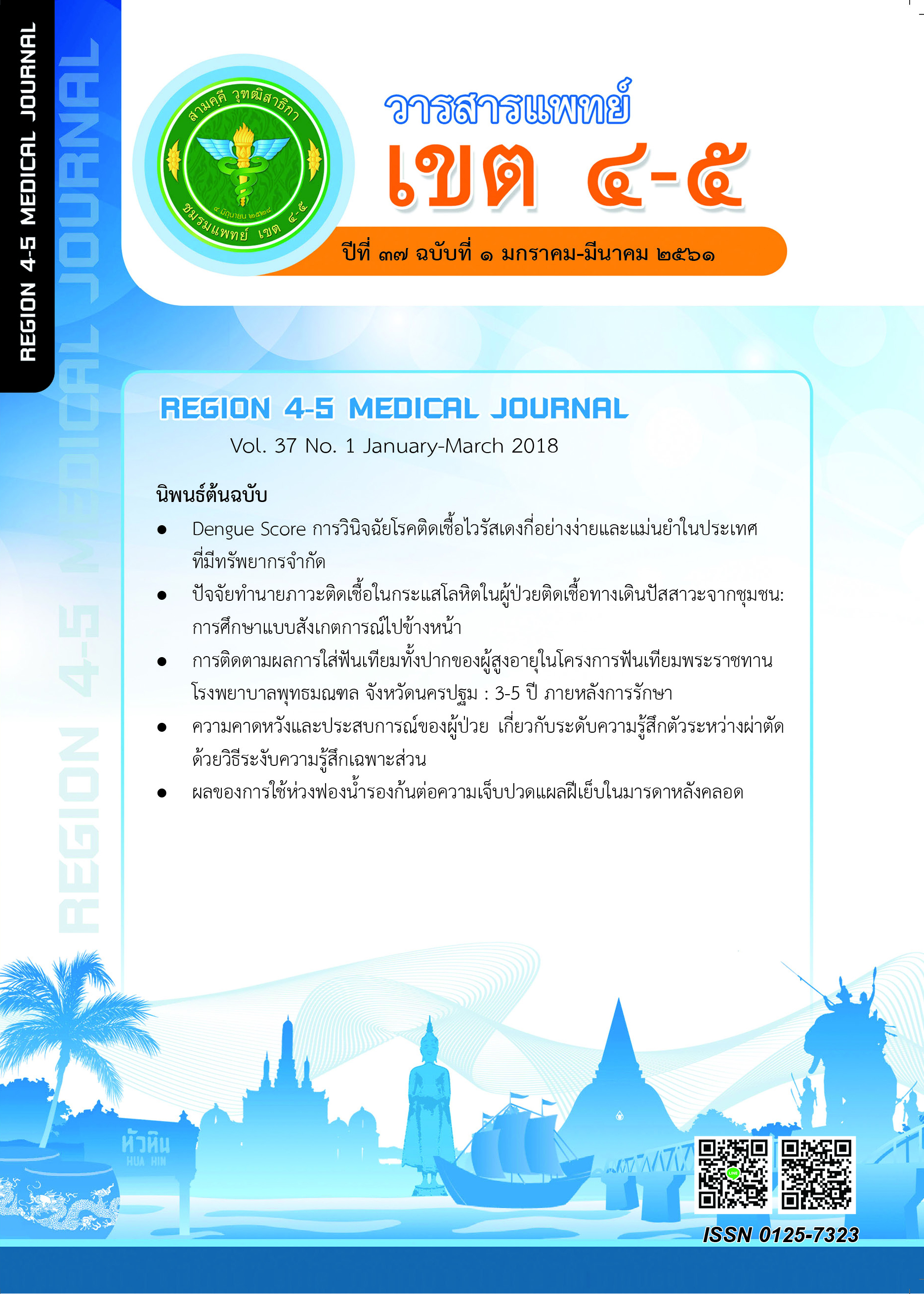Dengue Score การวินิจฉัยโรคติดเชื้อไวรัสเดงกี่อย่างง่ายและแม่นยำในประเทศที่มีทรัพยากรจำกัด
คำสำคัญ:
ปัญหาทางสุขภาพจิต; ชุมชนริมทางรถไฟมักกะสัน; กลุ่มเปราะบางบทคัดย่อ
วัตถุประสงค์: เพื่อศึกษาลักษณะทางคลินิกและการตรวจทางห้องปฏิบัติการที่ง่ายและจำเพาะในการวินิจฉัยแยกโรคติดเชื้อไวรัสเดงกี่กับโรคติดเชื้อฉับพลันอื่นๆ ในประเทศที่มีทรัพยากรจำกัด
วัสดุและวิธีการศึกษา: เป็นการศึกษาไปข้างหน้าในโรงพยาบาลนครปฐม โรงพยาบาลตติยภูมิ ขนาดเตียง 670 เตียง ระหว่างวันที่ 1 สิงหาคม ถึง 31 ตุลาคม 2558 กลุ่มตัวอย่างที่เลือกเข้าทำการศึกษาคือ ผู้ป่วยผู้ใหญ่ มีไข้ฉับพลัน และแพทย์ผู้ดูแลสงสัยโรคติดเชื้อไวรัสเดงกี่ นำมาวิเคราะห์หาปัจจัยทางคลินิกในการวินิจฉัยโรคติดเชื้อไวรัสเดงกี่
ผลการศึกษา: ผู้ป่วยทั้งสิ้น 155 ราย อายุเฉลี่ย 33.5 ± 17.1 ปี ร้อยละ 51 เป็นเพศหญิง พบการติดเชื้อไวรัสเดงกี่ 113 ราย (ร้อยละ 73) และการติดเชื้ออื่นๆ 42 ราย (ร้อยละ 27) ปัจจัยทำนายการติดเชื้อไวรัสเดงกี่ ได้แก่ การไม่มีอาการไอ (OR 0.3, 95%CI 0.1;0.9, p= 0.04), WBC ≤ 4x103/mm3 (OR 4.6, 95%CI 1.2;17.0, p0.02), platelet ≤ 100x103/mm3 (OR 6.6, 95%CI 1.5;29.8, p= 0.01) และ ESR ≤ 20 mm/hr (OR 3.3, 95%CI 1.01;12.3, p= 0.047) เมื่อนำปัจจัยดังกล่าวมาวิเคราะห์หา Dengue Score โดยการไม่มีปัจจัยดังกล่าวให้คะแนน = 0 และการมีปัจจัยดังกล่าวให้คะแนน = 1 ได้ดังนี้ (-1.3xcough) + (1.5xWBC<4X103/mm3) + (1.9xplatelet<100x103/mm3) + (1.2xESR<20) โดยถ้า Dengue score มากกว่าหรือเท่ากับ 2 จะสามารถใช้วินิจฉัยโรคติดเชื้อไวรัสเดงกี่ได้ มีความไว ความจำเพาะ ค่าทำนายผลบวก และค่าทำนายผลลบ เท่ากับร้อยละ 58, ร้อยละ 95, ร้อยละ 98 และร้อยละ 38 ตามลำดับ
สรุป: อาการและอาการแสดงของโรคติดเชื้อไวรัสเดงกี่คล้ายกับการติดเชื้อฉับพลันอื่นๆ แยกออกจากกันได้ยาก Dengue Score สามารถใช้ในการวินิจฉัยโรคติดเชื้อไวรัสเดงกี่ได้อย่างแม่นยำในประเทศที่มีทรัพยากรจำกัด
เอกสารอ้างอิง
2. Suttinont C, Losuwanaluk K, Niwatayakul K, et al. Causes of acute, undifferentiated, febrile illness in rural Thailand: results of a prospective observational study. Ann Trop Med Parasitol 2006;100(4):363-70.
3. Mackenzie JS, Gubler DJ, Petersen LR. Emerging flaviviruses: the spread and resurgence of Japanese encephalitis, West Nile and dengue viruses. Nat Med 2004;10(12 Suppl):S98-S109.
4. อมร ลีลารัศมี. ไข้ฉับพลันที่ไม่ทราบสาเหตุ.ใน: นลินี อัศวโภคี, บรรณาธิการ. ประสบการณ์ด้านโรคติดเชื้อในประเทศไทย. พิมพ์ครั้งที่ 2. กรุงเทพฯ: สมาคมโรคติดเชื้อแห่งประเทศไทย; 2542. หน้า 1-12.
5. Capeding MR, Chua MN, Hadinegoro SR, et al. Dengue and other common causes of acute febrile illness in Asia: an active surveillance study in children. PLoS Negl Trop Dis 2013;7(7):e2331.
6. World Health Organization, Regional Office for South-East Asia. Dengue [Internet] [cited 2016 Aug 31]. Available from: URL: http://www.searo.who.int/entity/vector_borne_tropical_diseases/data/data_factsheet/en/
7. Ho TS, Wang SM, Lin YS, et al. Clinical and laboratory predictive markers for acute dengue infection. J Biomed Sci 2013;20:75.
8. Liu JW, Lee IK, Wang L, et al. The usefulness of clinical practice based laboratory data in facilitating the diagnosis of dengue illness. Bio Med Res Int 2013;2013:198797.
9. Lai WP, Chien TW, Lin HJ, et al. A Screening tool for dengue fever in children. Pediatr Infect Dis J 2013;32(4):320-324.
10. Daumas RP, Passos SR, Oliveira RV, et al. Clinical and laboratory features that discriminate dengue from other febrile illnesses: a diagnostic accuracy study in Rio de Janeiro, Brazil. BMC Infect Dis 2013;13:77.
11. Cucunawangsih, Dewi BE, Sungono V, et al. Scoring Model to Predict Dengue Infection in the Early Phase of Illness in Primary Health Care Centre. [cited 2016 June 30]; Arch Clin Microb. 2015 6:2. Available from: URL: http://www.acmicrob.com.
12. Shih-Tien Pan, Po-AnSu, Kuo-TaiChena, et al. Comparison of the clinical manifestations exhibited by dengue and nondengue patients among children in a medical center in southern Taiwan. Acute Med 2014;4(2):53-6.
13. Watt G, Jongsakul K, Chouriyagune C, et al. Differentiating dengue virus infection from scrub typhus in Thai adults with fever. Am J Trop Med Hyg 2003;68(5):536-8.
14. Epelboin L, Boulle C, Ouar-Epelboin S, et al. Discriminating malaria from dengue fever in endemic areas: clinical and biological criteria, prognostic score and utility of the c-reactive protein: a retrospective matchedpair study in French Guiana. PLoS Negl Trop Dis 2013:7(9):e2420.
15. CDC DoV-BD. Dengue: Clinical Guidance. 2016 Jan 20. [cited 2017 Jan 22]. Available from: URL: https://www.cdc.gov/dengue/clinicalLab/laboratory.html
16. Kalayanarooj S, Nimmannitya S. A Study of erythrocyte sedimentation rate in dengue hemorrhagic fever. Southeast Asian J Trop Med Public Health 1989;20(3):325-30.
17. Souza LJ, Reis AF, de Almeida FC, et al. Alteration in the erythrocyte sedimentation rate in dengue patients: analysis of 1,398 cases. Braz J Infect Dis 2008;12(6):472-5.
18. Halstead SB. Dengue. Lancet 2007;370:1644-52.
19. Samanta J, Sharma V. Dengue and its effects on liver. World J Clin Cases 2015;3(2):125-31.
20. Fernando S, Wijewickrama A, Gomes L, et al. Patterns and causes of liver involvement in acute dengue infection. BMC Infect Dis 2016;16:319.
21. Kuo HJ, Lee IK, Liu JW. Analyses of clinical and laboratory characteristics of dengue adults at their hospital presentations based on the World Health Organization clinicalphase framework: Emphasizing risk of severe dengue in the elderly. J Microbiol Immunol Infect 2017:S684-1182(17)30067-1.
ดาวน์โหลด
เผยแพร่แล้ว
รูปแบบการอ้างอิง
ฉบับ
ประเภทบทความ
สัญญาอนุญาต
ลิขสิทธิ์บทความเป็นของผู้เขียนบทความ แต่หากผลงานของท่านได้รับการพิจารณาตีพิมพ์ลงวารสารแพทย์เขต 4-5 จะคงไว้ซึ่งสิทธิ์ในการตีพิมพ์ครั้งแรกด้วยเหตุที่บทความจะปรากฎในวารสารที่เข้าถึงได้ จึงอนุญาตให้นำบทความในวารสารไปใช้ประโยชน์ได้ในเชิงวิชาการโดยจำเป็นต้องมีการอ้างอิงถึงชื่อวารสารอย่างถูกต้อง แต่ไม่อนุญาตให้นำไปใช้ในเชิงพาณิชย์




